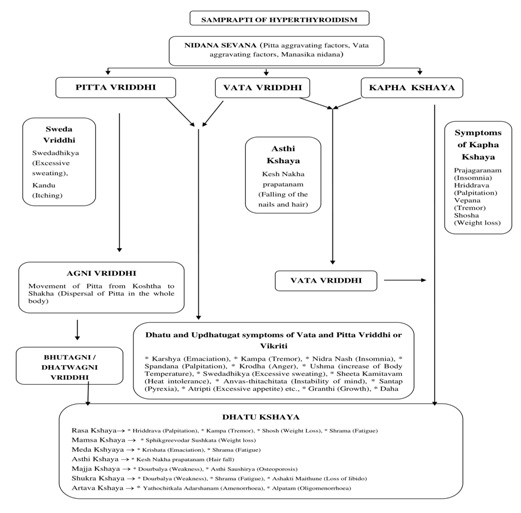Evaluation of Dosha Dushya Involvement and their Pattern in the Patients of Hyperthyroidism as per Principles of Ayurveda: A Review
DOI:
https://doi.org/10.47070/ayushdhara.v8i6.831Keywords:
Ayurveda, Dosha Dushya Sammurchana, Pitta vriddhi, Vata vriddhi, Kapha kshayaAbstract
Ayurveda is most scientific ancient science that has been evolved to provide treatment to chronic and non-communicable diseases in all over world. Holistic approach of Ayurveda provide cure not only to the physical but to mental and spiritual body as well. Over the years, the valuable experiences of many physicians (Vaidyas) have been adding to this traditional method.
As the anatomical and physiological knowledge of the human body was not so accurate and update in old days so the exact structure and function of any structural and functional unit of body is not available in any classical Ayurvedic texts. The endocrine system is a group of glands that prepare and secretes chemical substances, hormones that control various body functions. Due to lack of exact knowledge of endocrine glands, these glands and its pathological induced disorders are not so precisely described in Ayurvedic lexicon. But by the different name, various pathological conditions described in Ayurveda have some resemblance with endocrinal diseases.
Hyperthyroidism is a condition in which the gland thyroid makes too much T4, T3, or both. The signs and symptoms of thyroid diseases may be compared to Ayurvedic diseases like Galganda, Atyagni, Bhasmaka and Atikarshya. Pitta vriddhi, Vata vriddhi and Kapha kshaya collectively is a condition that may be supposed to be similar to the symptoms of Hyperthyroidism and it may be substantiated by more and more study. This review may provide beneficial description on Ayurvedic view on Hyperthyroidism that may be further useful.
Downloads

Downloads
Published
Issue
Section
License
Copyright (c) 2021 AYUSHDHARA

This work is licensed under a Creative Commons Attribution-NonCommercial-ShareAlike 4.0 International License.


